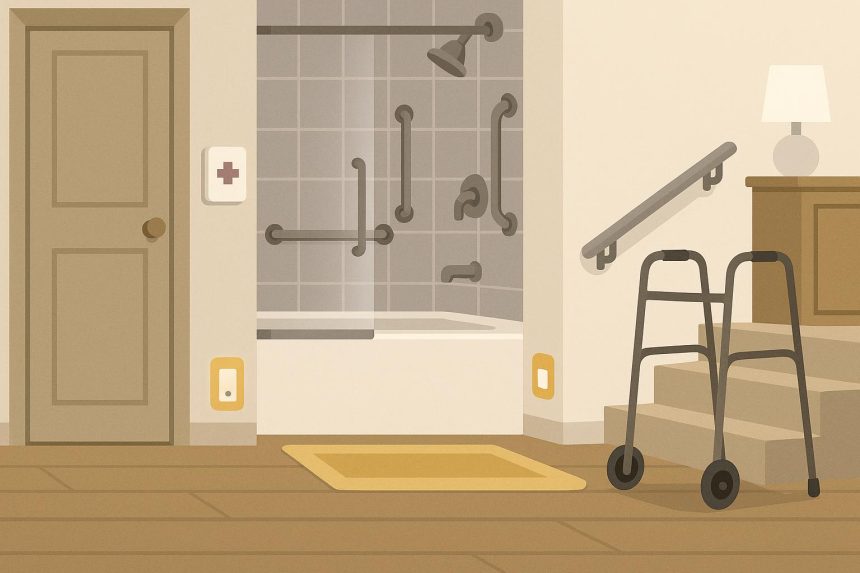Most families start researching assisted living facilities right after a parent has a scary fall or close call. The panic sets in, and suddenly everyone’s talking about selling the house and finding a good care home. But here’s what gets missed in that moment of fear: the vast majority of seniors who move to care facilities weren’t actually unable to live at home. They just didn’t have the right setup.
The difference between aging at home and being forced into institutional care often comes down to a handful of practical changes. Not renovations that cost tens of thousands of dollars, and not round-the-clock supervision. Just smart upgrades that address the actual risks seniors face every single day.
The Bathroom Problem Nobody Wants to Talk About
Bathrooms cause more senior injuries than any other room in the house, which makes sense when you think about it. Wet surfaces, hard floors, awkward positions, and the fact that people are often alone and partially undressed when something goes wrong. The statistics are pretty grim – falls in bathrooms account for about 80% of home injuries in people over 65.
Grab bars make the biggest difference, but they have to go in the right spots. The toilet area needs support bars on both sides, positioned so seniors can lower themselves down and push themselves back up without that wobbling moment where balance gets sketchy. The shower needs horizontal bars at chest height, not those vertical ones that are useless when someone’s actually slipping.
Walk-in tubs sound good in theory, but they create their own problem – sitting there wet and cold while the tub drains. A barrier-free shower with a built-in seat and handheld showerhead works better for most people. Add a shower chair that doesn’t slide around, and suddenly bathing stops being the most dangerous part of the day.
The toilet height matters more than people realize. Standard toilets sit too low for seniors with knee or hip issues. Raised toilet seats or comfort-height toilets (a couple inches taller) reduce the strain and the fall risk that comes from struggling to stand up.
The Technology That Actually Prevents Emergencies
Here’s where things get interesting. The traditional medical alert button has been around for decades, but it only works if someone can actually press it. Falls that knock people unconscious or leave them too disoriented to reach the button create the exact scenario these devices were supposed to prevent.
Modern senior monitoring devices that protect from falls have changed this equation completely. They use sensors that detect when someone has fallen and automatically alert emergency contacts or monitoring services, even if the person can’t press anything. For seniors living alone or those with conditions that increase fall risk (Parkinson’s, balance disorders, medication side effects that cause dizziness), this technology fills a critical gap.
The other piece that matters is medication management. Pills getting taken late, doses getting doubled accidentally, or medications getting skipped entirely – these mistakes send seniors to the hospital constantly. Automatic pill dispensers with alarms and lockout features prevent the “did I already take my morning pills?” confusion that leads to dangerous errors.
Motion sensors placed strategically around the house can alert family members if normal patterns change. No movement in the kitchen by 10 AM when Mom usually makes coffee by 7? That’s worth a phone call. These systems aren’t about surveillance – they’re about catching problems early, before a small issue becomes a medical emergency.
Lighting That Prevents the 3 AM Disaster
The majority of serious falls happen at night when seniors get up to use the bathroom. The combination of darkness, grogginess, and rushing to avoid an accident creates perfect conditions for a devastating fall. But lighting fixes are straightforward and surprisingly cheap.
Motion-activated night lights along the path from bedroom to bathroom eliminate the fumbling for light switches in the dark. The lights need to be bright enough to actually see by, not those dim decorative ones that barely glow. LED strips under bed frames and along baseboards create a lit pathway without the harsh overhead lights that make it hard to fall back asleep.
Illuminated light switches with large rocker panels replace those tiny toggle switches that are impossible to find in the dark. Three-way switches in bedrooms let seniors turn lights on from bed before standing up, which prevents that disoriented stumbling in darkness that causes so many middle-of-the-night falls.
The Kitchen Changes That Matter
Kitchens present their own risks, mostly related to reaching, bending, and the cognitive load of managing multiple tasks. Lowering one section of counter creates a workspace where seniors can sit on a stool instead of standing for long periods. Upper cabinets can be fitted with pull-down shelving systems that bring items to counter height instead of requiring step stools or overreaching.
Induction cooktops shut off automatically if nothing’s on them and don’t get hot to the touch, which prevents both burns and the house fires that start when someone forgets the stove is on. Some models have timers that cut power after a set period, adding another layer of protection.
Smart smoke detectors and carbon monoxide detectors that connect to phones give family members immediate alerts when something’s wrong. The devices can also be programmed to call emergency services directly if there’s no response from the senior within a set timeframe.
Flooring and Furniture Adjustments
Throw rugs are beautiful and also incredibly dangerous. They bunch up, corners flip over, and they slide on hard floors. Getting rid of them entirely makes more difference than almost any other single change. Area rugs that do stay need non-slip backing that actually grips the floor, not those thin rubber mesh pads that give a false sense of security.
Carpet transitions and thresholds between rooms create tripping hazards. Ramping these transitions or removing them completely eliminates a common fall trigger. Door thresholds can be replaced with low-profile versions that wheelchairs and walkers can roll over easily.
Furniture height matters for safety. Chairs and sofas that are too low make standing up difficult and increase fall risk. Seat cushions that add 3-4 inches or furniture risers under legs can bring seating up to a height where standing doesn’t require a dangerous push-off motion. Coffee tables with sharp corners get replaced with rounded edges or removed entirely from walking paths.
The Bottom Line on Staying Home
The cost of these modifications typically runs between $3,000 and $8,000 for a comprehensive safety upgrade. Compare that to assisted living facilities that average $4,500 per month, and the financial argument writes itself. But the real value isn’t financial.
Seniors who age in their own homes maintain better cognitive function, experience less depression, and generally report higher quality of life than those who move to institutional settings. The familiar environment, the neighborhood connections, the ability to keep routines and possessions – these things matter enormously for mental and physical health.
Most families wait for a crisis to make these changes, but that’s backwards. The time to upgrade safety is before the fall, before the emergency, before the conversation about selling the house comes up. A few practical modifications can buy years of safe, independent living at home. That’s not just good planning – it’s giving seniors what most of them want more than anything else: the chance to stay in the place they’ve built their lives.
Lynn Martelli is an editor at Readability. She received her MFA in Creative Writing from Antioch University and has worked as an editor for over 10 years. Lynn has edited a wide variety of books, including fiction, non-fiction, memoirs, and more. In her free time, Lynn enjoys reading, writing, and spending time with her family and friends.















